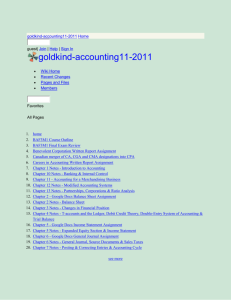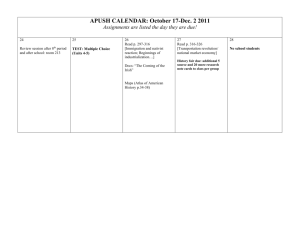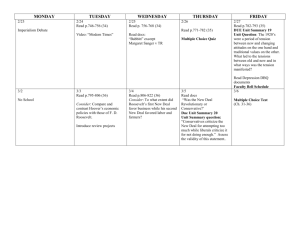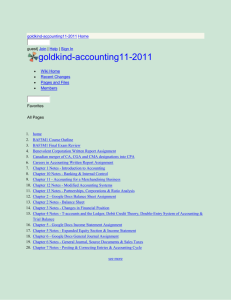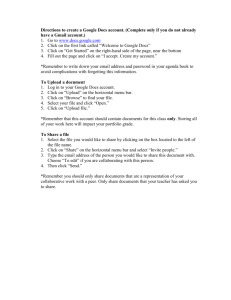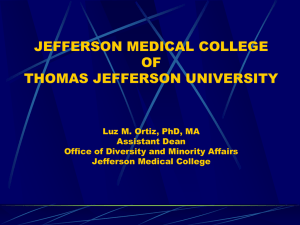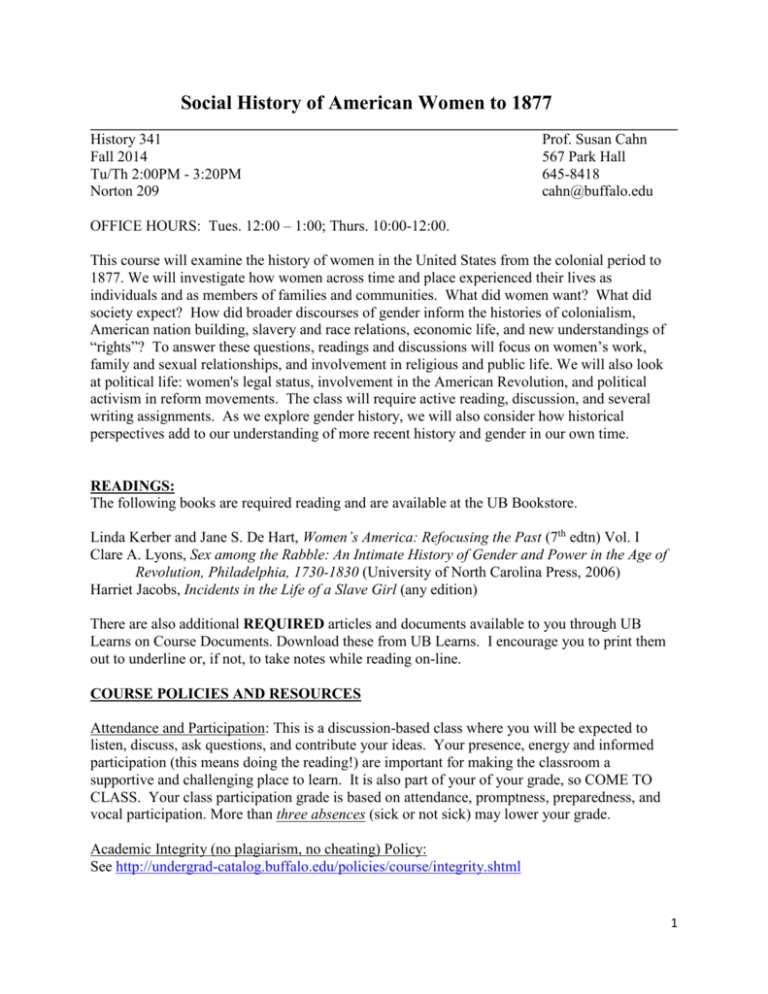
Social History of American Women to 1877
______________________________________________________________________________
History 341
Prof. Susan Cahn
Fall 2014
567 Park Hall
Tu/Th 2:00PM - 3:20PM
645-8418
Norton 209
cahn@buffalo.edu
OFFICE HOURS: Tues. 12:00 – 1:00; Thurs. 10:00-12:00.
This course will examine the history of women in the United States from the colonial period to
1877. We will investigate how women across time and place experienced their lives as
individuals and as members of families and communities. What did women want? What did
society expect? How did broader discourses of gender inform the histories of colonialism,
American nation building, slavery and race relations, economic life, and new understandings of
“rights”? To answer these questions, readings and discussions will focus on women’s work,
family and sexual relationships, and involvement in religious and public life. We will also look
at political life: women's legal status, involvement in the American Revolution, and political
activism in reform movements. The class will require active reading, discussion, and several
writing assignments. As we explore gender history, we will also consider how historical
perspectives add to our understanding of more recent history and gender in our own time.
READINGS:
The following books are required reading and are available at the UB Bookstore.
Linda Kerber and Jane S. De Hart, Women’s America: Refocusing the Past (7th edtn) Vol. I
Clare A. Lyons, Sex among the Rabble: An Intimate History of Gender and Power in the Age of
Revolution, Philadelphia, 1730-1830 (University of North Carolina Press, 2006)
Harriet Jacobs, Incidents in the Life of a Slave Girl (any edition)
There are also additional REQUIRED articles and documents available to you through UB
Learns on Course Documents. Download these from UB Learns. I encourage you to print them
out to underline or, if not, to take notes while reading on-line.
COURSE POLICIES AND RESOURCES
Attendance and Participation: This is a discussion-based class where you will be expected to
listen, discuss, ask questions, and contribute your ideas. Your presence, energy and informed
participation (this means doing the reading!) are important for making the classroom a
supportive and challenging place to learn. It is also part of your of your grade, so COME TO
CLASS. Your class participation grade is based on attendance, promptness, preparedness, and
vocal participation. More than three absences (sick or not sick) may lower your grade.
Academic Integrity (no plagiarism, no cheating) Policy:
See http://undergrad-catalog.buffalo.edu/policies/course/integrity.shtml
1
Academic misconduct includes acts in which a student seeks to claim credit for the work or
efforts of another without authorization or citation. Examples include but are not limited to:
a. Cutting and pasting text from the web without quotation marks or proper citation.
b. Paraphrasing from the web or written texts without crediting the source.
c. Using notes in an exam when such use is not allowed.
d. Using another person’s ideas, words, or research and presenting it as one’s own.
e. Submitting a paper in one class that you have or are going to submit in another without asking
for permission from your professors.
Accessibility Resources:
If you require classroom or testing accommodations due to a disability, please contact
Accessibility Resources, located at 25 Capen Hall. AR can be reached by phone at (716) 6452608 or by email at stu-accessibility@buffalo.edu. I encourage students with disabilities
receiving accommodations through AR to discuss these with me, after class or during my office
hours, so that I may be better informed on how to assist you during the semester.
Computers and Cell Phones
I ask that you do not use laptops in class unless, for reasons of disability and accessibility, you
need one to fully participate in lecture. Let me know if this is the case. I also ask that you turn off
cell phones before lecture starts, and keep them in your bag for the duration of lecture.
Life Going Awry?
While my wish for you is a great semester, sometimes life becomes complicated. If this is the
case, please let me know as soon as possible so that we can make arrangements in order that you
survive and flourish during the semester. Be aware of drop, add, withdraw dates and policies.
LEARNING OBJECTIVES
These refer to the content and skills this course will help you to master. The objectives listed
below will be assessed in the various assignments for the course. We’ll talk specifically about
the task, my expectations, and the criteria for grading before each assignment.
Historical Knowledge/Content
History 341 introduces students to major themes and ideas in the study of the women and gender
history before 1877. It challenges them to think about women’s history and the formation of
gender in a more complex light. And it demands that they interrogate the place of women and
gender in the making of the United States, thus integrating women’s history into broader
knowledge of U.S. and related histories.
Historical Thinking
History 341 also introduces students to historical thinking and the historical method. It provides
them with the opportunity to analyze new kinds of texts, particularly primary sources. It engages
students in the process of articulating historical problems for exploration, questioning sources,
and building arguments; in other words, to start thinking and writing like historians.
2
Historical and General Academic Skills
History 341 finally helps students develop historical skills. That is, it helps students develop
critical thinking skills, sharpen research, reading, and writing skills, and develop note-taking
skills and comprehension skills. In addition, students will hone their oral skills with discussion
contribution, posing questions, and formal presentations.
Assignment
First Essay
Second
Essay
Reading
Responses
Presentation
Discussion
Contribution
Final Exam
Knowledge
Thinking
Skills
Describing Explaining Cause & Problems Critical
past
past
effect
& uses of reading
evidence
x
x
x
x
Analytical Oral
writing & presentation
argument
x
x
x
x
x
x
x
x
x
x
x
x
x
x
x
x
x
x
x
x
x
x
x
x
x
x
ASSIGNMENTS
Reading Responses
First Essay
Second Essay
Presentation
Class Participation
Final Exam
x
x
x
x
= 20%
= 15%
= 15%
= 10%
= 20%
= 20%
Reading Responses
For nine of the weeks that the class meets, you have the opportunity to write a reading response.
Five of these times—four of your choice and one (on 10/9) mandatory, you must submit a
reading response of 300 – 500 words (1 to 2 pages, handed in Thursday in class) answering the
Reading Response Question given for that week. I will count off if it is significantly shorter or
longer than the page limit and will not accept late reading responses. The responses will be
evaluated for content, comprehension, and writing. You will also get an opportunity to revise
three of your responses for an increase in your grade.
WEEKLY TOPICS AND READINGS
8/26
INTRODUCTIONS
UNIT I: CONTACT, CONFLICT AND EARLY SETTLEMENT
8/28
Worlds Across the Atlantic
READ:
3
Nancy Shoemaker, “How Indians Got to Be Red,” American Historical Review 102 (June
1997): 625-644.
Kathleen Brown, “The Anglo-Algonquin Frontier” in Good Wives, Nasty Wenches and
Anxious Patriarchs (U. of North Carolina Press, 1996), 26-48.
9/2
Contact and Conquest, 1500-1700
READ:
Morgan, “Some Could Suckle over Their Shoulder,” WA, 37-46.
Berkin, “African American Women in Colonial Society,” WA, 90-97.
DOCS: “The Law of Slavery and Freedom,” WA, 98-102.
9/4
New England Society: Harmony and Conflict
READ:
Ulrich, “The Ways of Her Household,” WA, 47-56.
Norton, “Searchers again Assembled,” WA, 61-60.
DOCS: “The Law of Domestic Relations” and “The Trial of Anne Hutchinson,” WA, 5760, 71-75.
9/9
Women, War, and Witchcraft
READ:
Karlsen, “The Devil in the Shape of a Woman: The Economic Basis of Witchcraft,” WA,
76-89.
Mary Beth Norton, “Gospel Women,” intro and conclusion, from In the Devil’s Snare:
The Salem Witchcraft Crisis of 1692 (NY: Knopf, 2002), 3-13, 44-81, 295-308.
9/11
Salem in Popular Culture
FILM
FIRST ESSAY DUE FRIDAY, 9/12
9/16
Spanish and French Conquest
READ:
Juliana Barr,“From Captives to Slaves: Commodifying Indian Women in the
Borderlands,” The Journal of American History, 92 (June 2005): 19-46.
Susan Sleeper-Smith, “Women, Kin, and Catholicism: New Perspectives on the Fur
Trade,” Ethnohistory 47 (Spring 2000): 423-52.
9/18
Family Economy and “Trade”
READ:
Ann Little, “Captivity and Conversion,” in WA, 103-116.
Dayton, “Taking the Trade,” WA, 116-133.
4
UNIT TWO: GENDER IN THE ERA OF THE AMERICAN REVOLUTION
9/23
The Revolutionary Era: Sex, Pleasure, and Compliance
READ:
Lyons, Sex among the Rabble, 1-114.
9/25
Revolution in Print
READ:
Lyons, Sex among the Rabble, 115-182.
9/30
Mary Silliman’s War
FILM
READ: (for Thur. Lyons, Sex among the Rabble, 183-308)
10/2
Sex in the City: Wartime Possibilities
READ:
Lyons, Sex Among the Rabble, 183-308.
10/7
Republican Chaos or Republican Motherhood
READ:
Lyons, Sex Among the Rabble, 309-353
Kerber, “The Republican Mother and the Woman Citizen,” WA, 147-153.
10/9
Revolutionary Backlashes: Sex in the Early 19th Century
READ:
Lyons, Sex Among the Rabble, 354-396.
MANDATORY READING RESPONSE:
Question: What is the overall argument of Lyon’s book? How do her three sections substantiate
that argument?
UNIT THREE: GENDER, DOMESTICITY & THE CONTRADICTIONS OF SLAVERY
10/14 Domestic Economies and the New Ideology of Domesticity
READ:
Jean Boydston, “The Pastoralization of Housework,” in WA, 174-185.
Caroll Smith-Rosenberg, “The Female World of Love and Ritual,” in WA, 189-204.
DOCS: “Moral Reform” Docs in Course Docs.
10/16 Factory Women
READ:
Christine Stansell, “Harrowing Truths: Manufacturing Work,” in City of Women: Sex and
Class in New York, 1789-1860 (Univ. of Illinois, 1987), 105-129.
DOCS: “Lowell Offering” and “Lowell Letters” in Course Docs.
5
10/21 Enslaved Childhood and Motherhood
READ:
Harriet Jacobs, Incidents in the Life of a Slave Girl, ch. I to XV
10/23 Escape from Slavery?
READ:
Jacobs, Incidents, ch. XVI to XXV
FILM CLIP: Twelve Years a Slave
10/28 Fugitive or Free:
READ:
Jacobs, Incidents, ch. XXVI to XLI (end)
10/30 GROUP PRESENTATIONS: PRIMARY SOURCE ANALYSIS
UNIT FOUR: CIVIL RIGHTS AND CIVIL WARS
11/04 Women’s Antislavery Activism
READ:
Susan Zaeske, “Signatures of Citizenship,” in WA, 224-232.
DOCS: “Claiming Rights I,” in WA, 233-237.
11/6
Woman’s Rights: The Declaration of Sentiments
READ:
Gerda Lerner, “The Meaning of Seneca Falls, 1848-1998,” in WA, 257-263.
DOCS: “Claiming Rights II” and “Photograph of Sojourner Truth” in WA, 264-271.
“Vote Docs” in Course Docs.
11/11 Civil War: Southern Experiences
READ:
Drew Faust, “Enemies in Our Households,” in WA, 283-294.
DOCUMENTS: “Counterfeit Freedom,” in WA, 295-297.
11/13 Civil War: Northern Women Serve and Organize
READ:
Louisa Alcott, Hospital Sketches, 3-96.
http://archive.org/stream/hospitalsketche00alco#page/n0/mode/2up/search/1
11/18 Aftermaths: The Meaning of Emancipation
READ:
Tera Hunter, “Reconstruction and the Meanings of Freedom,” in WA, 298-308.
DOCS: “Counterfeit Freedom,” in WA, 295-297
6
Hannah Rosen, "'Not That Sort of Women': Race, Gender, and Sexual Violence During
the Memphis Riot of 1866," in Women, Families, and Communities V. 2, ed.
Nancy A. Hewitt and Kirsten Delegard (New York: Pearson Longman, 2nd
edition, 2008), 10-30.
11/20 (Un)Settling the Trans-Mississippi West
READ:
Rose Stremlau, “‘I Know What an Indian Woman Can Do’” in WA, 272-282.
Sarah Winnemucca, from Life among the Piutes in Luckett and Olwell, Women in the
West (Antelope Island Press, 1982).
11/25 Women Migrants to the West: Life in Rural America
Susan Gaspell, “A Jury of Her Peers,” from Every Week (March 5, 1917), 370-85.
SECOND ESSAY DUE IN (or before) CLASS
11/27 HAPPY THANKSGIVING
12/2
East to West and the Clash of Cultures
READ:
Connie Young Yu, “The World of Our Grandmothers,” in Making Waves: An Anthology
of Writrings by and about Asian American Women, ed. by Asian Women United
of California (Beacon Press, 1989), 33-42.
Sucheng Chan, “The Exclusion of Chinese Women,” in Kathryn K. Sklar and Thomas Dublin,
eds., Women and Power in American History, 3rd ed. (Prentice Hall, 2009), 150-161.
FINAL EXAM HANDED OUT
12/4
Race and the Woman’s Rights Movement
READ:
Ellen DuBois, “Outgrowing the Compact of the Fathers: Equal Rights, Woman Suffrage
and the United States Constitution, 1820-1878,” JAH 74 (Dec. 1987): 836-62.
DOC: “The Women’s Centennial Agenda, 1876” in WA, 331-333.
DISCUSS FINAL EXAM
FINAL EXAM DUE Thurs., December 11 (in Park Hall 567) by 4:00
7

